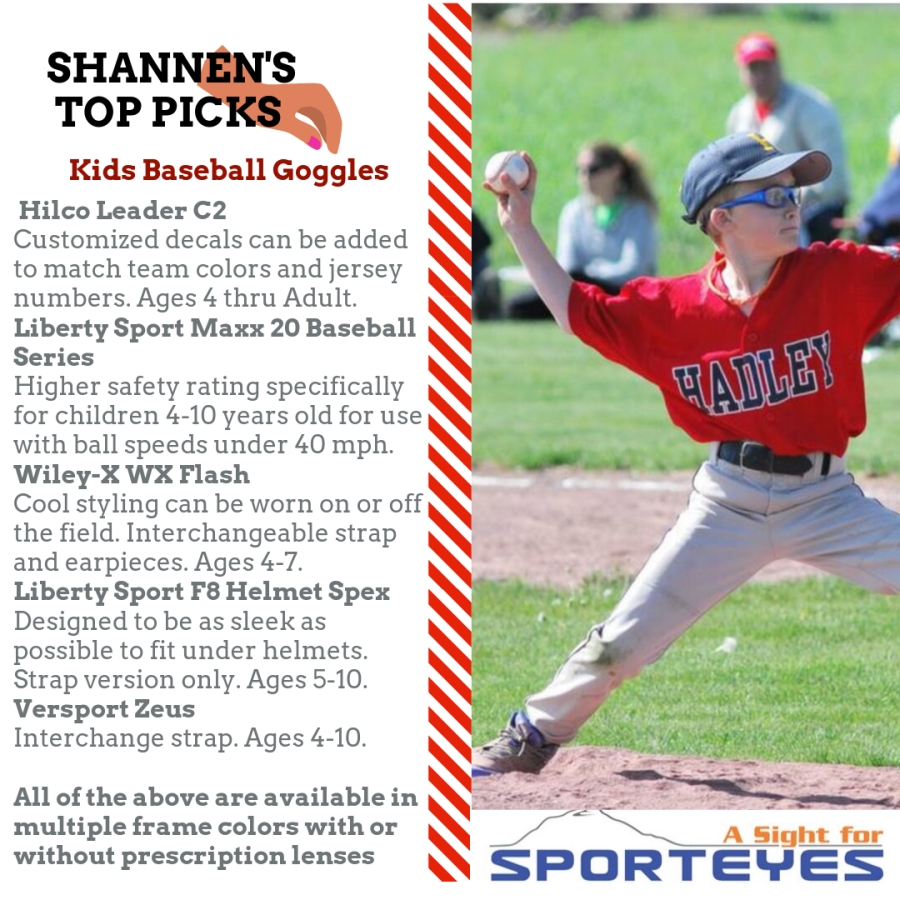-
According to the National Society to prevent blindness, almost 7,000 injuries were related to playing baseball. This is the injuries that were reported, so the number can be even more than that. Typically, the injury is sustained from a ball striking the batter or runner directly in the eye. Injuries can be prevented through using sport goggles. These goggles give protection from injury, but can also fit with your prescription in them. Here are some helpful tips when choosing goggles:
Polycarbonate Lenses: This is the most important property of all protective goggles. Good polycarbonate (referred as PC) is virtually unbreakable, and will sustain the impact of a ball. 2mm PC is what is recommended for the ASTM safety standard. Low end PC will have a lot of distortion in the lens which may reduce reaction time. High end PC lenses to decrease distortion. Trivex or NXT based products can also be considered. Trivex has better impact resistance than CR-39 plastic (but not as high as PC) but has minimal distortion. In prescription, this is a great choice.
Durable Frame Design: The frame must also be able to withstand the impact of a ball. A PC frame is the best choice. Frames rated with ASTM F803 standard is the best choice. This is a government sports safety standard that encompasses all ball/stick sports. This rating also ensures lenses are a certain mm thick PC for the best impact resistance. A popular choice for baseball is also a shield design where the whole front of the frame is a lens made out of PC, with temples made of plastic or some other material. This is also a suitable choice, and if you play at different times of the day, the shield can be interchanged with other colors to block sunlight (see Lens colors). Yet, most shields do not meet the ASTM safety rating. Look for at least ANSI Z87+ (military safety rating) standard for shields to make sure better impact resistance than standard sunglass frames. (note: not recommended for younger player and still could cause a significant eye injuries for older players as the lenses have not been tested for ball sport safety)
UV Protection: Since baseball is played outdoors, you need to protect yourself from ultraviolet radiation. (For more information, see UV and its Effects on the Eyes
). Anytime you go with a high quality PC or Trivex /NXT lens, UV will automatically be included in the lenses even with clear lenses.
Lens Color: If you are playing during the day, the sun can be blinding, typically for outfielders. A tinted lens, a brown one, can help you distinguish the ball better against the blue of the sky or the green of the grass. If playing at night, you want the lens to be clear to give the best visual acuity. An anti-reflective coating can also be placed on the lens to absorb extra glare off the stadium lighting. The downside to Anti-reflective coatings are they have to be clean. This may be inconvenient in a sports environment. A yellow lens can also be used to cut the glare of overhead lighting if you are light sensitive. Yet, the lens color may reduce visual acuity slowing down reaction times if the field is not well lit. You also don’t want use yellow if you have a colored ball (i.e. softball) as it does change color perception.
Sports Band: Traditional sports goggles have a sports band attached to it, but for shield designs, it is advisable to get a sports band to make sure the frame stays on your face.
Prescription Lenses: PC or Trivex lenses are the materials that should be used for prescription lenses for safety reasons.
Recommended Styles Liberty Sport, Hilco, Progear, Wiley-X, Bolle and Versport for sports goggles that meet ASTM standards for sports, or Wiley-X , Rudy Project, and Tifosii (tactical products only) (do not meet ASTM standards but are more stylish and have ANSI ratings). These styles can be fit with a prescription lens or insert.
Flip ups and other options: If you are not concerned with the safety standards, Rudy Projecthas a flip up styles: the Exception which is also available with a prescription lens. Flip ups let you quickly flip down a sun lens for catching fly balls. Also, the Gargoyles flip ups as well (no prescription available). Peakvision also has their dual lens technology so that the lens is darker at the top and lighter at the bottom. This blocks more light from above, but makes sure it is not too dark for more natural vision when looking at the field. The lower part of the lens is also an amber color to increase contrast.
To Improve Your Game: Check out our vision training products including the Bat-Rac here.

